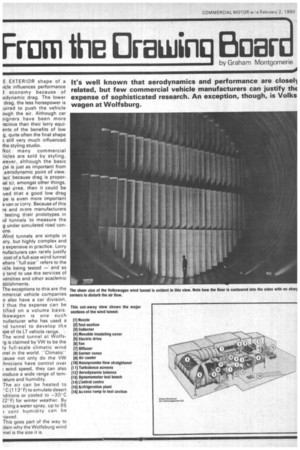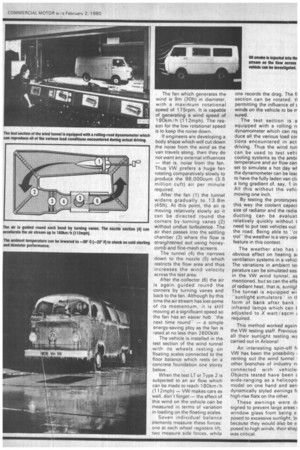From the Drawing Boer
Page 80

Page 81

If you've noticed an error in this article please click here to report it so we can fix it.
by Graham Montgomerie
E EXTERIOR shape of a iicle influences performance I economy because of °dynamic drag. The lower drag, the less horsepower is uired to push the vehicle ough the air. Although car signers have been more iscious than their lorry equiants of the benefits of low g, quite often the final shape s still very much influenced the styling studio.
Not many commercial iicles are sold by styling, Never, although the basic pe is just as important from a,erodynamic point of view. 'act because drag is proporla! to, amongst other things, Ttal area, then it could be ued that a good low drag pe is e\ven more important a van or lorry. Because of this re and more manufacturers testing their prototypes in id tunnels to measure the g under simulated road conons.
Nind tunnels are simple in ory, but highly complex and y expensive in practice. Lorry nufacturers can rarely justify cost of a full-size wind tunnel where ''full size" refers to the iicle being tested — and so y tend to use the seryjces of versities and other academic 3blishments.
The exceptions to this are the nmercial vehicle companies o also have a car division,
thus the expense can be tified on a volume basis. lkswagen is one such nufacturer who has used a id tunnel to develop the ipe of its LT vehicle range. The wind tunnel at Wolfs-g is claimed by VW to be the ly full-scale climatic wind inel in the world. -Climatic" cause not only do the VW ;hnicians have control over wind speed, they can also yroduce a wide range of tern-ature and humidity.
The air can be heated to ' C (113' F) to simulate desert iditions or cooled to -30 C 22°F) for winter weather. By acting a water spray, up to 95 r cent humidity can be iieved This goes part of the way to plain why the Wolfsburg wind inel is the size it is. The fan which generates the wind is 9m (30ft) in diameter, with a maximum rotational speed of 175rpm. It is capable of generating a wind speed of 180km /h (112mph). The reason for the low rotational speed is to keep the noise down.
If engineers are developing a body shape which will cut down the noise from the wind as the van travels along, then they do not want any external influences — that is, noise from the fan. Thus VW prefers a huge fan rotating comparatively slowly to produce the 98,000cum (3.5 million cult) air per minute required.
After the fan (1) the tunnel widens gradually to 13.8m (45ft). At this point, the air is moving relatively slowly so it can be directed round the corners by turning vanes (2) without undue turbulence. The air then passes into the settling chamber (3) where the flow is straightened out using honeycomb and fine-mesh screens.
The tunnel (4) the narrows down to the nozzle (5) which restricts the flow area and thus increases the wind velocity across the test area.
After the collector (6) the air is again guided round the corners by turning vanes and back to the fan. Although by this time the air stream has lost some of its momentum, it is still moving at a significant speed so the fan has an'easier hob "the next time round— a simple energy-saving ploy as the fan is rated at no less than 2600kW.
The vehicle is installed in the test section of the wind tunnel with its wheels resting on floating scales connected to the floor balance which rests on a concrete foundation one storey below.
When the test LT or Type 2 is subjected to an air flow which can be made to reach 180km /h (112mph) — VW makes cars as well, don't forget — the effect of this wind on the vehicle can be measured in terms of variation in loading on the floating scales.
Seven individual balance elements measure these forces: one at each wheel registers lift, two measure side forces, while one records the drag. The fl section can be rotated, tl permitting the influence of E winds on the vehicle to be rr sured.
The test section is a equipped with a rolling r( dynamometer which can rer duce all the various load cor tions encountered in act driving. Thus the wind tun can be used to test vehi cooling systems as the ambi temperature and air flow can set to simulate a hot day wt the dynamometer can be loac to have the fully laden van cli; a long gradient of, say, 1 in All this without the vehi, moving one inch.
By testing the prototypes this way the coolant capaci size of radiator and the radia ducting can be evaluat relatively quickly without t need to put test vehicles out the road. Being able to "cc trol'' the weather is a very use feature in this context.
The weather also has ; obvious effect on heating ai ventilation systems in a vehicl The variations in ambient ter perature can be simulated eas in the VW wind tunnel, as mentioned, but so can the effe of radiant heat, that is, sunliglThe tunnel is equipped wi -sunlight simulators" in tt form of bank after bank infrared lamps which can t adjusted to X watt /sqcm required.
This method worked again: the VW testing staff. Previous all their sunlight testing WE carried out in Arizona!
An interesting spin-off fi VW has been the possibility ; renting out the wind tunnel other branches of industry ni connected with vehicle: Objects tested have been E wide-ranging as a helicopt( model on one hand and aen dynamically styled awnings h high-rise flats on the other.
These awnings were di signed to prevent large areas window glass from being e. posed to excessive sunlight, hi because they would also be e posed to high winds, their shap was critical,








































































































































